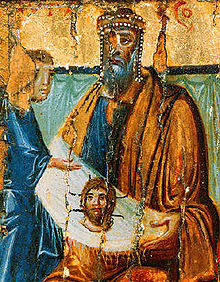
Back የጄኖቫ ቅዱስ መልክ Amharic منديل الرها Arabic Убрус Bulgarian Imatge d'Edessa Catalan Mandylion Czech Abgar-Bild German Άγιο Μανδήλιο Greek Tuko de Edessa Esperanto Mandylion Spanish Mandylion Finnish

According to Christian tradition, the Image of Edessa was a holy relic consisting of a square or rectangle of cloth upon which a miraculous image of the face of Jesus Christ had been imprinted—the first icon (lit. 'image'). The image is also known as the Mandylion (Greek: μανδύλιον, 'cloth' or 'towel'),[1] in Eastern Orthodoxy, it is also known as Acheiropoieton (Greek: Εἰκόν' ἀχειροποίητη, lit. 'icon not made by hand').
In the tradition recorded in the early 4th century by Eusebius of Caesarea,[2] King Abgar of Edessa wrote to Jesus, asking him to come cure him of an illness. Abgar received a reply letter from Jesus, declining the invitation, but promising a future visit by one of his disciples. One of the seventy disciples, Thaddeus of Edessa, is said to have come to Edessa, bearing the words of Jesus, by the virtues of which the king was miraculously healed. Eusebius said that he had transcribed and translated the actual letter in the Syriac chancery documents of the king of Edessa, but who makes no mention of an image.[3] The report of an image, which accrued to the legendarium of Abgar, first appears in the Syriac work, the Doctrine of Addai: according to it, the messenger, here called Ananias, was also a painter, and he painted the portrait, which was brought back to Edessa and conserved in the royal palace.[4]
The first record of the existence of a physical image in the ancient city of Edessa (now Urfa) was by Evagrius Scholasticus, writing about 593, who reports a portrait of Christ of divine origin (θεότευκτος), which effected the miraculous aid in the defence of Edessa against the Persians in 544.[5] The image was moved to Constantinople in the 10th century. The cloth disappeared when Constantinople was sacked in 1204 during the Fourth Crusade, and is believed by some to have reappeared as a relic in King Louis IX of France's Sainte-Chapelle in Paris. This relic disappeared in the French Revolution.[6]
The provenance of the Edessa letter between the 1st century and its location in his own time are not reported by Eusebius. The materials, according to the scholar Robert Eisenman, "are very widespread in the Syriac sources with so many multiple developments and divergences that it is hard to believe they could all be based on Eusebius' poor efforts" (Eisenman 1997:862).
The Eastern Orthodox Church observes a feast for this icon on August 16, which commemorates its translation from Edessa to Constantinople.
- ^ Guscin, Mark (2016-02-08). The Tradition of the Image of Edessa. Cambridge Scholars Publishing. p. 137. ISBN 9781443888752.
- ^ Eusebius, Historia Ecclesiae 1.13.5 and .22.
- ^ Steven Runciman, "Some Remarks on the Image of Edessa", Cambridge Historical Journal 3.3 (1931:238-252), p. 240
- ^ Runciman 1931, loc. cit..
- ^ Evagrius, in Migne, Patrologia Graecalxxxvi, 2, cols. 2748f, noted by Runciman 1931, p. 240, note 5; remarking that "the portrait of Christ has entered the class of αχειροποίητοι icons".
- ^ Two documentary inventories: year 1534 (Gerard of St. Quentin de l'Isle, Paris) and year 1740. See Grove Dictionary of Art, Steven Runciman, Some Remarks on the Image of Edessa, Cambridge Historical Journal 1931, and Shroud.com for a list of the group of relics. See also an image of the Gothic reliquary dating from the 13th century, in Histor.ws Archived 2012-02-07 at the Wayback Machine.
© MMXXIII Rich X Search. We shall prevail. All rights reserved. Rich X Search